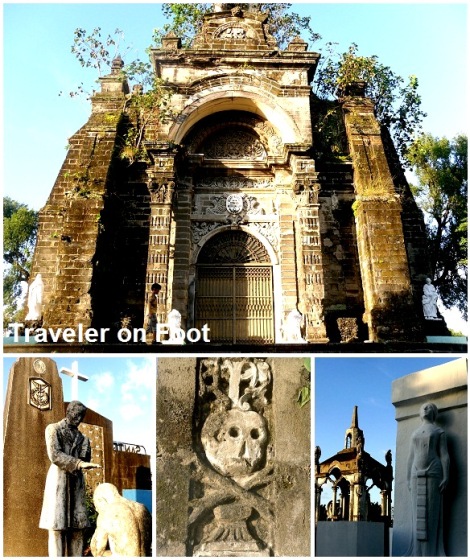
CEMENTERIO DE BINONDO. One of the places I always wanted to visit in Manila is the Campo Santo de La Loma. I’ve seen in old pictures the intricate wrought iron grill gate that led to the funerary chapel set in what they refer in the olden days as Cementerio de Binondo.
The Cementerio de Binondo was located approximately three kilometers away from the arrabal of Binondo, in the hilly area that was then part of the arrabal of Santa Cruz. Hence, Cementerio de Binondo was eventually called la loma or the hill, which makes up the cemetery complex of Cemeterio del Norte, the Manila Chinese Cemetery, and La Loma Cemetery. Of the three cemeteries, La Loma Cemetery was the first to be established.


CEMETERY ARCHITECTURE. The only way to the centuries-old funerary chapel was a good walk following the path that snakes through the cemetery compound. All the time I was diverting my son from imagining the Walking Dead by pointing out the different architectural styles found on the tombs and mausoleums.
The style and ornamentation in the memorials range from Gothic and Neo-classic to Art Deco. We found tombs and mausoleums that were recently built, but what make the cemetery-scape interesting are those that show years of exposure to the natural elements.


CAMPO SANTO DE LA LOMA. At every turn, we stop to see the details in the mausoleums with spires and the tombs with stone sculptures of Grecian goddesses in anguish and angels looking up to the heavens. These monuments crowd the cemetery lending the feeling of walking around a statue garden.
The La Loma Cemetery was built at the time when landscaping of cemeteries became popular in England and France. Before the garden cemeteries were established, the dead were buried inside churches. Evidence of this practice is seen today in grave markers on the floor and walls of old churches. The banning of the practice of interring the dead in churches following the sanitary standards of the time led to the creation of landscaped cemeteries that were set outside town or city limits.

BEATI MORTUI. We found the site of the old cemetery gate. What is left of the intricate wrought iron gate we saw in old pictures are the stone pillars with still discernible stone relief of human skulls and crossed bones. From the gate, we walked towards the medieval chapel. Funerary mass is no longer held in this baroque chapel. A new church dedicated to St. Pancratius has been built near the main road.
The church facade has detailed carvings. Above the main door are elaborate carvings with the year 1884 and a marker with the Latin text Beati mortui qui in domino moriuntur which translates to “Blessed are the dead who die in the grace of Lord.”

EPILOGUE. The chapel stood ancient, covered with moss and overgrowth. Its adobe walls muted gold in the afternoon sun. It was warm, but the breeze suddenly became chilly. It was days before November 1.
-All Saints Day 2012

Great photos!
thanks Darwin.
Beautiful photos, interesting article!
Thank you Aileen.-Glenn
My brothers and myself have been to La Loma just 2 weeks ago, to visit the graves of our parents and other relatives. My brother managed to take photos of old graves, and old tombstones, and there was no one who bothered us. La Loma has its quiet charm.
Your photos are excellent, especially the last one. Your explanations are also very good. Thank you for this post, which I’m reading now in the United States on Oct. 31, Halloween. (Do you often take your son on your outings? He must be getting a good education from you.)
I like your posts and I am also saddened by the fact that the management doesn’t allow you to take any pictures and you have to make a request form to be sign by all the priests from Caloocan to Manila and around the country.
Interesting article! Is the ban on picture-taking an official policy of the cemetery powers-that-be?
Great, interesting article. I love your photos, too. I particularly like your shots of the funerary chapel. I’ve always been fascinated with old cemeteries. I was at la loma cemetery last 2010 to take photos but my friend and i were told by the cemetery guard that taking photos is not allowed. Luckily, i was able to take some interesting shots of statues but not of the funerary chapel.
I don’t really understand why some people prohibit taking pictures in public places. I guess sometimes security personels love to power trip. Don’t be fooled. Go back to La Loma. Appreciate the place and take photos of the funerary chapel. -Glenn
Thank you, Glenn. I would definitely go back there.